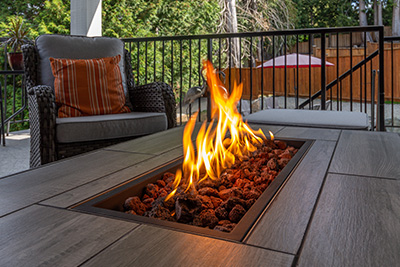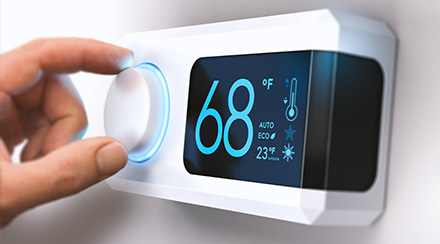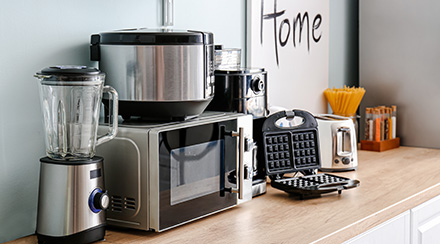How Much Does It Cost to Run a Gas Fireplace?

A fireplace isn’t always the most cost-effective way to keep warm, but there’s more to life than energy efficiency. A crackling fire is cozy and atmospheric in ways that traditional forced-air heating can’t match. And in the case of wood-burning fireplaces, it can also mean a lot of work and mess – which is why many homeowners opt to install gas fireplaces.
A natural-gas-burning fireplace can deliver all the warmth and whimsy of a wood-burning fire at the touch of a button. But how much does it cost to run a gas fireplace? The answer will take a little bit of number crunching and perhaps a close examination of the room where your gas fireplace is installed.
Calculating the Cost to Run a Gas Fireplace
While there are several factors that affect the true overall cost of running a gas fireplace, calculating the cost per hour of a specific gas fireplace is fairly simple. To start, you need to identify two data points: the gas fireplace’s BTU rating and the price of natural gas.
BTU stands for British Thermal Units, and one BTU is equivalent to the amount of heat required to increase the temperature of one pound of water by one degree Fahrenheit. For gas fireplaces, the BTU rating tells you how many BTUs the fireplace will consume in one hour at full, standard power. The easiest way to check the BTU rating of a gas fireplace is to refer to the original manual, but if that’s not available, you should be able to find the information on the fireplace itself.
The BTU rating, serial number, model number and other information is typically stamped or printed on a metal plate. This is usually located behind an access panel, along with the other hidden components of the fireplace. Depending on the gas fireplace’s type and size, the BTU rating could range from as low as 10,000 BTU to more than 100,000 BTU.
Next, check the price of natural gas. Utilities typically calculate natural gas in therms, with one therm equaling 100,000 BTU. You can check your last utility bill to see the price you were charged per therm during your last billing cycle, or you may be able to find a more up-to-date price on your gas utility’s website. Keep in mind that the cost of natural gas can fluctuate significantly and varies by location. According to the Bureau of Labor statistics, the national average price of natural gas per therm was $1.67 in December 2022, compared to $1.04 just five years earlier. Also in December 2022, the price per therm varied from $1.13 in Alaska to $2.87 in Miami – with an extreme outlier of $6.47 in Hawaii.
Now it’s time to calculate the cost to operate your gas furnace per hour. As an example, let’s say your gas fireplace is rated at 40,000 BTU and your natural gas is priced at $1.67, the national average from December 2022. First, multiply the BTU rating by the price of gas per therm, then divide the product of that calculation by 100,000.
40,000 x $1.67 = 66,800
66,800 / 100,000 = .668
.668 ≈ .67 cents per hour
This calculation gives you a helpful estimate of how much it will cost to run a gas fireplace for one hour, which you can then extrapolate to estimate the total monthly cost based on how frequently you use your fireplace. But as you’ll see below, there are several other factors that can affect the overall cost of running a gas fireplace.
What Can Increase the Cost to Run a Gas Fireplace for Heat?

If you use your gas fireplace purely for aesthetics, the cost per hour tells you everything you need to know. But if you’re also counting on your gas fireplace to keep you warm, there are several other energy-efficiency factors to take into consideration:
- Vented vs. ventless gas fireplaces. How does a gas fireplace work? It depends on whether it’s vented. A vented gas fireplace produces a warm flame, but the exhaust vents directly to the outdoors, which allows some of that heat to escape. A ventless gas fireplace is clean-burning and recycles the air in the room, making it comparatively more energy efficient for heating. There is a trade-off, though – some find that the bluish flames of a ventless fireplace don’t evoke fireplace “vibes,” and the recycled air can produce a faint odor.
- Type and age of gas fireplace. You may have an old-school artificial log set that works just fine, but it might consume a huge quantity of BTUs with relatively little heat output. Modern gas fireplace designs, including gas fireplace inserts and standalone gas fireplaces, may give you better bang for your buck. Compare the specs of your old fireplace with what’s on the market today to get an idea of how much you could improve your fireplace energy efficiency.
- BTU rating relative to the room. Gas fireplaces aren’t practical for heating an entire home, but they can do a fine job of heating one room. The bigger the room, the higher the BTU rating must be to adequately heat it. Refer to the product specs of any new gas fireplace you’re considering to ensure that it’s appropriate for the space. An oversized gas fireplace will waste energy, while an undersized fireplace will leave the room feeling too cold.
- Insulation and air leaks. If the room in which your gas fireplace is installed is poorly insulated or has air leaks around doors, windows or cracks, you’ll need to use the fireplace more frequently to stay warm. You can repair air leaks by replacing worn weather stripping and using spray foam or caulk to fill in cracks. Adding additional attic insulation can be a DIY job, but upgrading wall insulation, doors or windows is typically a job for professionals.
- Other heat sources. Because gas fireplaces aren’t practical for heating large homes by themselves, there’s often a whole-home furnace or heat pump involved as well. In a home with HVAC zone control, you can save energy by turning off the primary HVAC in the room when you’re running the fireplace. Without zone control, you can turn down the thermostat if everyone in the home is gathered near the fireplace, or you can reduce the fireplace flame to avoid producing excessive heat.
Installing a gas fireplace can be a great way to add both beauty and comfort to your home, but it will also add to your wintertime gas bills. There’s no need to be surprised by the cost, though – simply calculate your gas fireplace’s cost per hour, and make sure the room is sealed and insulated to hold on to all that cozy warmth.
Looking for Something Specific?
Select a category to find resources for topics that interest you.
Select Category

Related Articles:

Tips for Improving Your AC and Furnace Efficiency
We share maintenance tips for your heater and AC, and home improvement tips to help you use those systems less.
Read Article
Tips for Saving on Energy in Your Home
If you’re looking to learn more about energy efficiency for home systems and appliances, we’re sharing our favorite energy-saving tips.
Read Article
What Uses the Most Electricity In a Home?
We break down what uses the most energy in your home to give you an understanding of where your energy usage goes and where energy-saving tactics can make the most impact.
Read ArticleMost Popular Articles

Energy Plans to Fit Your Lifestyle
NRG offers electricity and natural gas plans with perks like cash back, travel rewards and more, so you can find a plan that fits your home and family.
How Much Does It Cost to Run a Gas Fireplace?
A fireplace isn’t always the most cost-effective way to keep warm, but there’s more to life than energy efficiency. A crackling fire is cozy and atmospheric in ways that traditional forced-air heating can’t match. And in the case of wood-burning fireplaces, it can also mean a lot of work and mess – which is why many homeowners opt to install gas fireplaces.
A natural-gas-burning fireplace can deliver all the warmth and whimsy of a wood-burning fire at the touch of a button. But how much does it cost to run a gas fireplace? The answer will take a little bit of number crunching and perhaps a close examination of the room where your gas fireplace is installed.
Calculating the Cost to Run a Gas Fireplace
While there are several factors that affect the true overall cost of running a gas fireplace, calculating the cost per hour of a specific gas fireplace is fairly simple. To start, you need to identify two data points: the gas fireplace’s BTU rating and the price of natural gas.
BTU stands for British Thermal Units, and one BTU is equivalent to the amount of heat required to increase the temperature of one pound of water by one degree Fahrenheit. For gas fireplaces, the BTU rating tells you how many BTUs the fireplace will consume in one hour at full, standard power. The easiest way to check the BTU rating of a gas fireplace is to refer to the original manual, but if that’s not available, you should be able to find the information on the fireplace itself.
The BTU rating, serial number, model number and other information is typically stamped or printed on a metal plate. This is usually located behind an access panel, along with the other hidden components of the fireplace. Depending on the gas fireplace’s type and size, the BTU rating could range from as low as 10,000 BTU to more than 100,000 BTU.
Next, check the price of natural gas. Utilities typically calculate natural gas in therms, with one therm equaling 100,000 BTU. You can check your last utility bill to see the price you were charged per therm during your last billing cycle, or you may be able to find a more up-to-date price on your gas utility’s website. Keep in mind that the cost of natural gas can fluctuate significantly and varies by location. According to the Bureau of Labor statistics, the national average price of natural gas per therm was $1.67 in December 2022, compared to $1.04 just five years earlier. Also in December 2022, the price per therm varied from $1.13 in Alaska to $2.87 in Miami – with an extreme outlier of $6.47 in Hawaii.
Now it’s time to calculate the cost to operate your gas furnace per hour. As an example, let’s say your gas fireplace is rated at 40,000 BTU and your natural gas is priced at $1.67, the national average from December 2022. First, multiply the BTU rating by the price of gas per therm, then divide the product of that calculation by 100,000.
40,000 x $1.67 = 66,800
66,800 / 100,000 = .668
.668 ≈ .67 cents per hour
This calculation gives you a helpful estimate of how much it will cost to run a gas fireplace for one hour, which you can then extrapolate to estimate the total monthly cost based on how frequently you use your fireplace. But as you’ll see below, there are several other factors that can affect the overall cost of running a gas fireplace.
What Can Increase the Cost to Run a Gas Fireplace for Heat?
If you use your gas fireplace purely for aesthetics, the cost per hour tells you everything you need to know. But if you’re also counting on your gas fireplace to keep you warm, there are several other energy-efficiency factors to take into consideration:
- Vented vs. ventless gas fireplaces. How does a gas fireplace work? It depends on whether it’s vented. A vented gas fireplace produces a warm flame, but the exhaust vents directly to the outdoors, which allows some of that heat to escape. A ventless gas fireplace is clean-burning and recycles the air in the room, making it comparatively more energy efficient for heating. There is a trade-off, though – some find that the bluish flames of a ventless fireplace don’t evoke fireplace “vibes,” and the recycled air can produce a faint odor.
- Type and age of gas fireplace. You may have an old-school artificial log set that works just fine, but it might consume a huge quantity of BTUs with relatively little heat output. Modern gas fireplace designs, including gas fireplace inserts and standalone gas fireplaces, may give you better bang for your buck. Compare the specs of your old fireplace with what’s on the market today to get an idea of how much you could improve your fireplace energy efficiency.
- BTU rating relative to the room. Gas fireplaces aren’t practical for heating an entire home, but they can do a fine job of heating one room. The bigger the room, the higher the BTU rating must be to adequately heat it. Refer to the product specs of any new gas fireplace you’re considering to ensure that it’s appropriate for the space. An oversized gas fireplace will waste energy, while an undersized fireplace will leave the room feeling too cold.
- Insulation and air leaks. If the room in which your gas fireplace is installed is poorly insulated or has air leaks around doors, windows or cracks, you’ll need to use the fireplace more frequently to stay warm. You can repair air leaks by replacing worn weather stripping and using spray foam or caulk to fill in cracks. Adding additional attic insulation can be a DIY job, but upgrading wall insulation, doors or windows is typically a job for professionals.
- Other heat sources. Because gas fireplaces aren’t practical for heating large homes by themselves, there’s often a whole-home furnace or heat pump involved as well. In a home with HVAC zone control, you can save energy by turning off the primary HVAC in the room when you’re running the fireplace. Without zone control, you can turn down the thermostat if everyone in the home is gathered near the fireplace, or you can reduce the fireplace flame to avoid producing excessive heat.
Installing a gas fireplace can be a great way to add both beauty and comfort to your home, but it will also add to your wintertime gas bills. There’s no need to be surprised by the cost, though – simply calculate your gas fireplace’s cost per hour, and make sure the room is sealed and insulated to hold on to all that cozy warmth.
Looking for Something Specific?
Select a category to find resources for topics that interest you.
Select Category

Related Articles:

Tips for Improving Your AC and Furnace Efficiency
We share maintenance tips for your heater and AC, and home improvement tips to help you use those systems less.
Read Article
Tips for Saving on Energy in Your Home
If you’re looking to learn more about energy efficiency for home systems and appliances, we’re sharing our favorite energy-saving tips.
Read Article
What Uses the Most Electricity In a Home?
We break down what uses the most energy in your home to give you an understanding of where your energy usage goes and where energy-saving tactics can make the most impact.
Read ArticleMost Popular Articles

Energy Plans to Fit Your Lifestyle
NRG offers electricity and natural gas plans with perks like cash back, travel rewards and more, so you can find a plan that fits your home and family.







